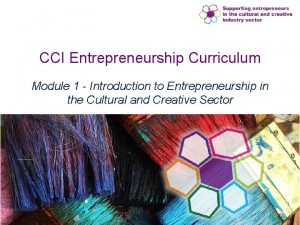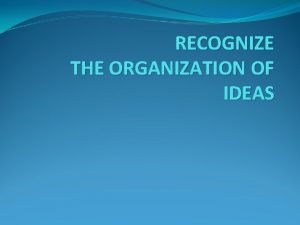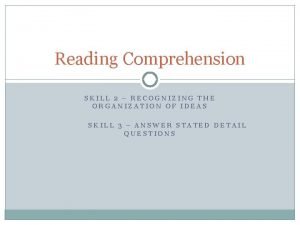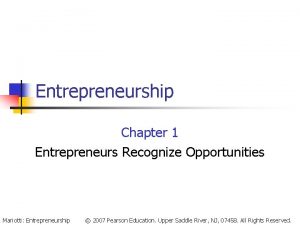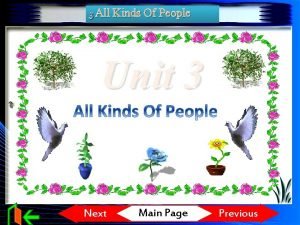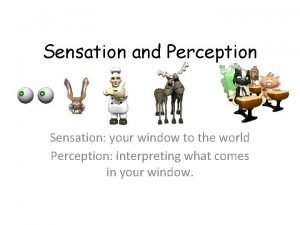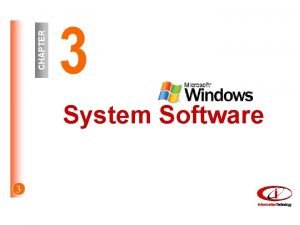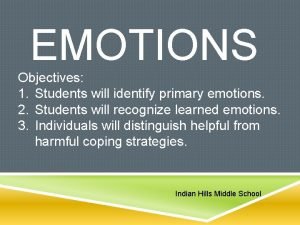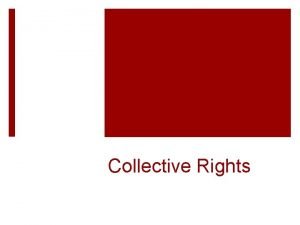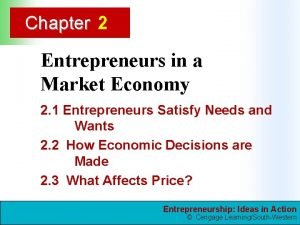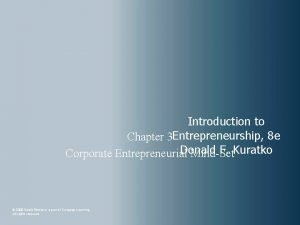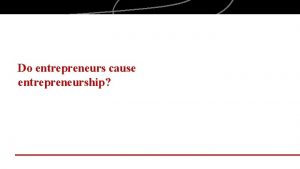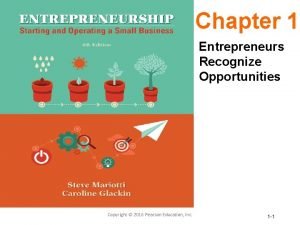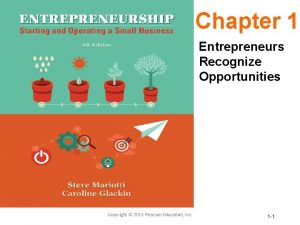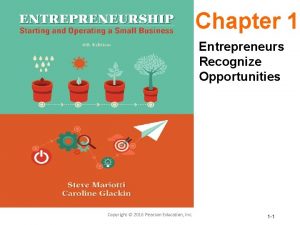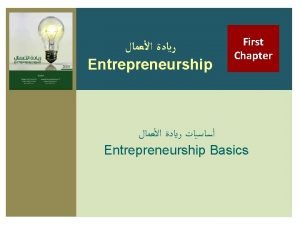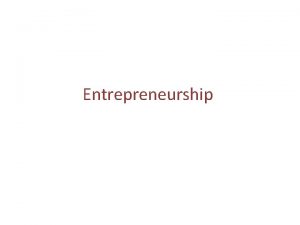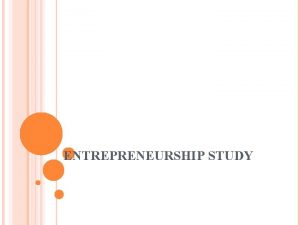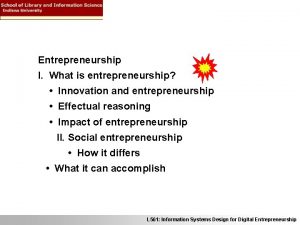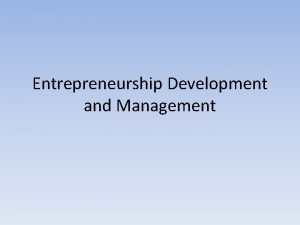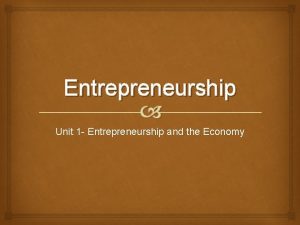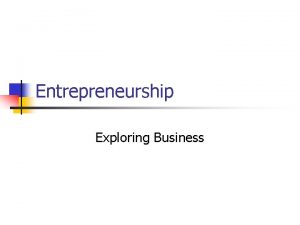Entrepreneurship Chapter 1 Entrepreneurs Recognize Opportunities What Is


















- Slides: 18

Entrepreneurship Chapter 1 Entrepreneurs Recognize Opportunities

What Is Business? n Business—buying and selling of products and services. n n Product—exists in nature or is made by human beings and is tangible. Service—work that provides time, skills, or expertise and is intangible. Entrepreneurship, 2 nd Edition Mariotti and Glackin with NFTE 2 © 2010 Pearson Education, Upper Saddle River, NJ 07458. All Rights Reserved.

What Is an Entrepreneur? n n Employees—earn their living working for someone else’s business. Entrepreneurs—earn their living starting, owning, and working for their own business. Entrepreneurship, 2 nd Edition Mariotti and Glackin with NFTE 3 © 2010 Pearson Education, Upper Saddle River, NJ 07458. All Rights Reserved.

Entrepreneurs Add Value to Scarce Resources n n A scarce (limited) resource is something of value that can be used to make something else or fill a need. Entrepreneurs add value to scarce resources by shifting them from areas of lower to higher productivity. Entrepreneurship, 2 nd Edition Mariotti and Glackin with NFTE 4 © 2010 Pearson Education, Upper Saddle River, NJ 07458. All Rights Reserved.

The Economic Questions n n n What should be produced? When will it be produced? How will it be produced? Who will produce it? Who gets what is produced? An economy is a country’s financial structure. It is the system that produces and distributes wealth. Entrepreneurship, 2 nd Edition Mariotti and Glackin with NFTE 5 © 2010 Pearson Education, Upper Saddle River, NJ 07458. All Rights Reserved.

What Is a Small Business? n 0 to 500 full-time employees n n n Approximately 99. 9% of the 26. 8 million U. S. businesses are small. Small businesses employ about 50% of the U. S. private workforce. Annual sales < $5 million Entrepreneurship, 2 nd Edition Mariotti and Glackin with NFTE 6 © 2010 Pearson Education, Upper Saddle River, NJ 07458. All Rights Reserved.

Why Be an Entrepreneur? n n n Control over time Fulfillment Creation/Ownership Control over compensation Control over working conditions Entrepreneurship, 2 nd Edition Mariotti and Glackin with NFTE 7 © 2010 Pearson Education, Upper Saddle River, NJ 07458. All Rights Reserved.

Costs and Benefits of Entrepreneurship Costs n Business failure n Obstacles n Loneliness n Financial insecurity n Long hours/hard work Entrepreneurship, 2 nd Edition Mariotti and Glackin with NFTE 8 Benefits n Independence n Satisfaction n Financial reward n Self-esteem © 2010 Pearson Education, Upper Saddle River, NJ 07458. All Rights Reserved.

Cost/Benefit Analysis n n Cost/Benefit Analysis—listing costs and benefits in order to make decisions that are not emotional n Costs—money and time invested n Benefits—money earned and knowledge and experience gained Opportunity Cost—cost of the next-best investment For cost/benefit analysis to be accurate, opportunity cost must be included. Entrepreneurship, 2 nd Edition Mariotti and Glackin with NFTE 9 © 2010 Pearson Education, Upper Saddle River, NJ 07458. All Rights Reserved.

Entrepreneurship Options n n n Traditional for-profit enterprise Social entrepreneurship including venture philanthropy Green entrepreneurship Entrepreneurship, 2 nd Edition Mariotti and Glackin with NFTE 10 © 2010 Pearson Education, Upper Saddle River, NJ 07458. All Rights Reserved.

Shumpeter’s Sources of Opportunity § § § Use a new technology to produce a new product. Use an existing technology to produce an old product in a new way. Find a new source of resources to produce more efficiently. Develop a new market for an existing product. Entrepreneurship, 2 nd Edition Mariotti and Glackin with NFTE 11 © 2010 Pearson Education, Upper Saddle River, NJ 07458. All Rights Reserved.

Not All Ideas Are Opportunities An opportunity is an idea that is based on what customers need or want and are willing to buy sufficiently often at a high enough price to sustain the business. Entrepreneurship, 2 nd Edition Mariotti and Glackin with NFTE 12 © 2010 Pearson Education, Upper Saddle River, NJ 07458. All Rights Reserved.

Timmon’s Business Opportunity= Idea + 4 Characteristics 1. 2. 3. 4. Attractive to customers Will work in the business environment Can be executed in an existing window of opportunity Resources and skills to create the business available to the entrepreneur Entrepreneurship, 2 nd Edition Mariotti and Glackin with NFTE 13 © 2010 Pearson Education, Upper Saddle River, NJ 07458. All Rights Reserved.

Use SWOT to Evaluate Business Ideas n Strengths n Weaknesses n Opportunities n Threats Entrepreneurship, 2 nd Edition Mariotti and Glackin with NFTE 14 © 2010 Pearson Education, Upper Saddle River, NJ 07458. All Rights Reserved.

Roots of Opportunity 1. 2. 3. 4. 5. Problems Changes Inventions Competition Technological advances Where others see problems, entrepreneurs recognize opportunities. Entrepreneurship, 2 nd Edition Mariotti and Glackin with NFTE 15 © 2010 Pearson Education, Upper Saddle River, NJ 07458. All Rights Reserved.

Pathways to Entrepreneurship n n n Start from the beginning Buy an existing business Secure franchise rights License technology (Do not steal someone else’s creativity) Entrepreneurship, 2 nd Edition Mariotti and Glackin with NFTE 16 © 2010 Pearson Education, Upper Saddle River, NJ 07458. All Rights Reserved.

Profit Is the Signal n n n Profit—amount of money earned after costs are paid Profit signals that an entrepreneur is adding value to scarce resources. Entrepreneurs try to make choices (trade-offs) that will increase profit. Entrepreneurship, 2 nd Edition Mariotti and Glackin with NFTE 17 © 2010 Pearson Education, Upper Saddle River, NJ 07458. All Rights Reserved.

Rules for Building a Successful Business 1. 2. 3. 4. 5. 6. 7. Recognize an opportunity Evaluate it with critical thinking (SWOT) Build a team Create a business plan Gather resources Establish ownership Create wealth Entrepreneurship, 2 nd Edition Mariotti and Glackin with NFTE 18 © 2010 Pearson Education, Upper Saddle River, NJ 07458. All Rights Reserved.
 Introduction to entrepreneurship module pdf
Introduction to entrepreneurship module pdf How does katniss plan to strike at the careers
How does katniss plan to strike at the careers The organization of ideas
The organization of ideas Skill 2 recognize the organization of ideas
Skill 2 recognize the organization of ideas Israel palestine
Israel palestine How to recognize opportunity in business
How to recognize opportunity in business Left realists recognize street crime as
Left realists recognize street crime as Chronic hyperplastic candidiasis
Chronic hyperplastic candidiasis Lars didn't recognize patrick logan because
Lars didn't recognize patrick logan because Old woman young woman
Old woman young woman Article v the teacher and the teaching community
Article v the teacher and the teaching community 3 system software
3 system software Example of useful materials and harmful materials
Example of useful materials and harmful materials Leading coefficient of a polynomial
Leading coefficient of a polynomial Refusing to recognize an emotion
Refusing to recognize an emotion What does beowulf do before he swims back to land?
What does beowulf do before he swims back to land? What laws recognize the collective rights of the metis
What laws recognize the collective rights of the metis Entrepreneurs in a market economy
Entrepreneurs in a market economy Entrepreneurship chapter 3
Entrepreneurship chapter 3
